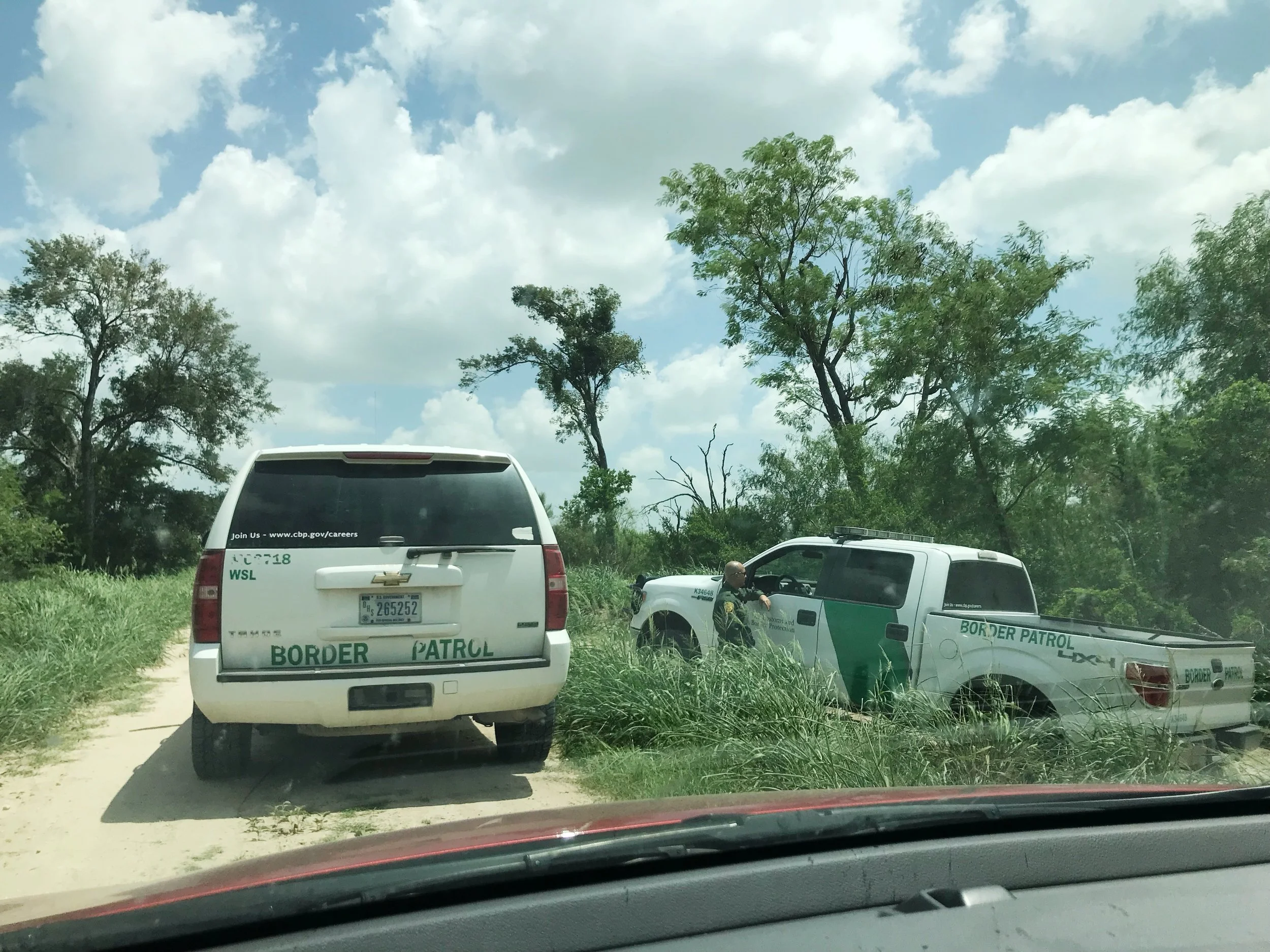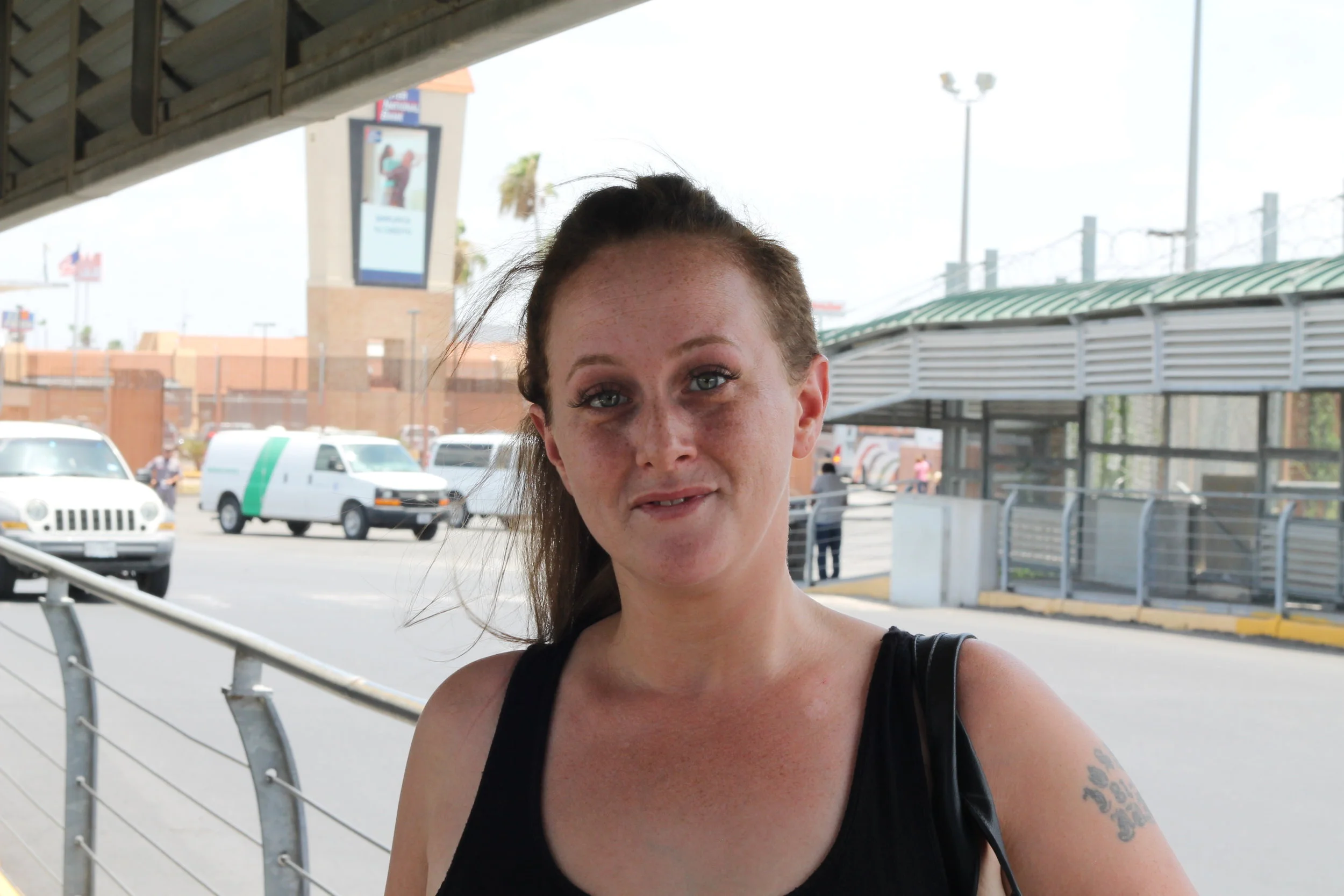(Editor's note: the last two photos in this post are slideshows that can be operated by clicking on the sides of the photos.)
It turns out you shouldn't always rely on Google Maps.
Tuesday morning we went on a hunt for the river. The Rio Grande serves as a natural boundary between Texas and Mexico. It's an area where there is no wall for many miles in either direction.
I drove down a dirt path that Google stated is a public road. It was extremely narrow. No room for two cars. There were times when I had to slowly, and barely, dodge major ruts. The Stooges' "No Fun" played on the stereo as I half-joked we were going to drive up on a bad situation or encounter Border Patrol. The further I drove down the path and the tougher it got, the more my adrenaline level ticked up and I felt a twinge of uneasiness in my stomach.
Eventually we parked the car and decided to walk the remaining short distance to the river.
As soon we exited the car, we were greeted with a loud noise that kind of felt like a distress call. At times it was deafening. It sounded like an alarm of some sort. It was a little of creepy.
Turns out it was hundreds of giant cicadas, which have the much cooler Mexican name: chicharra grande.
The chicharra grande, which has to be twice the size of those in Oklahoma.
After walking a few hundred feet we came up to a berm that separated us from the Rio Grande. It was thick with various plants that made it impassable in shorts.
Disappointed we had failed to actually see the river, we returned to the car and drove back toward the main road. As we neared the beginning of the path, I could see in the distance a Border Patrol SUV blocking our path and the officer standing behind it. As soon as I pulled up behind him a second Border Patrol vehicle drove up an embankment and parked next to the SUV.
Officer Garza approached our Hyundai, which is a great little car, and then informed me we were not supposed to venture down that road. He took my ID and passed it off to the officer in the truck to ensure I didn't have any warrants. Garza returned to check the trunk and then questioned me on why we were there.
After learning we are down here for journalistic reasons, Garza went back and talked to the other officer for a few minutes before giving back my license. He was stern, but friendly. He suggested if we wanted to see the river we drive west to the Hidalgo-Reynosa Bridge.
I really wasn't surprised to have a run-in with Border Patrol. They have eyes in the sky. They patrol the area. It felt like we were someplace we weren't supposed to be, but there was Google guiding us.
I couldn't help but think about those who possibly tried entering our country in the area I was in. The wooded areas were dense with trees and wild plants that would make passing through at night extremely tough. The best chance for speed would be the path I drove.
From the time we turned down that road to the time we encountered Border Patrol was just under 30 minutes. We have no idea when they spotted our car or how, but they closed in on us fast.
I'd be interested to learn about how often they come into contact with those crossing the border in that area. I can't imagine it's that many. Seems way too high risk. I wasn't even going to try to ask the officer anymore questions than I did. I was ready to move on.
We parked in a shopping center lot and walked a block south to the McAllen Hidalgo International Bridge, which serves as a vehicular and pedestrian crossing between the two countries.
Peter and I both have passports, so we decided to go check out the river and then pop in for a quick visit to our southern neighbor.
We each paid a dollar to go through a turnstile and started walking on the bridge when a woman approached us and started chatting us up.
Crystal was born and raised in Chicago. Still lives there. She used vacation time to visit her family. Her husband was deported a year and half ago after being pulled over and arrested for driving with no license. She elected to send their four children to live with him because two had disabilities, including one who had two brain surgeries after suffering up to 90 seizures a day. She mentioned healthcare was better in the US, but medicine is cheaper in Mexico. She said she made the trip frequently over the last year.
Crystal.
As we walked along the bridge I noticed ahead of us were two Border Patrol agents walking a group of young men into Mexico. The guys were carrying what looked like papers and a bag. They went into a separate building when we got to the immigration center.
Crystal was curious about why we were going into Reynosa. She seemed genuinely concerned for our well being. She warned us it was a bad place. She was going to straight to the bus from the immigration center and then on to see her family.
"Be careful. They see you and they smell blood," she said before we parted ways. When I thanked her for the conversation and wished her luck, she shook my hand and said, "seriously, be careful if you go into the city. It's not safe."
So then Peter and I went for a walk in the city. By the way, we never had to present a passport to enter Reynosa.
I was stunned by what I saw.
A couple blocks past the border it looked like a city struggling to stay alive. We passed numerous closed casinos and sports books. Night clubs looked like they had been vacant for at least a decade, some longer.
The further we went from the border the less people we saw on the streets, which felt odd for a metro area of 1.5 million people. Occasionally we'd pass a business with one or two people in it and they'd give us a glance then go about their business.
Maybe it was the constant concern from loved ones about my trip. Maybe it was all the reports of cartel violence in the area. Maybe it was what Crystal said. I felt alert. A little on edge.
The environment I was in didn't help. It felt like I was walking through a war-torn city left with little hope to return to its days of thriving businesses and nights of wild parties in the clubs. The only thing missing were the sounds of bombs going off in the distance.
There seemed to be an overwhelming number of people who were elderly or had a disability. There were some homeless.
As we walked along a sidewalk, a young woman walked up beside me and asked, "how you like it on our side?" She laughed then turned to look at me and I realized she was missing an eye.
As we walked around a block looking at buildings, I noticed a man on a roof of a nearby building following our progress. As we turned the corner, so did he. After a minute or two of taking photos, I looked up to see him staring down at us. I suddenly felt real uneasy and said it was time to go.
Again, it could have been all the voices in my head, but he didn't look friendly, and I didn't want to wait around to see if he wanted to meet us.
When returning, we had to show our passports on the bridge to Mexican police then again at US Customs, where the agent couldn't believe we had voluntarily walked into Reynosa. It was then I realized Crystal was the only non-Mexican American we had seen during our time in Mexico, and she wouldn't even walk beyond the plaza where we entered the country.
Peter and I had walked at least 15-20 city blocks total and I definitely felt more out of place than I ever have. There's no way I would walk into that city at night, but I'd be willing to return another day.
It was an eye-opening experience to see a city that sits directly across the bridge be so drastically worse off than anywhere I've witnessed before.
After a fun meal with Jennie's dad and stepmom, we took a short break before driving over to Brownsville to scout it out before returning Wednesday.
We agreed to pop into a local bar and try to talk to some locals about the immigration crisis and what it's like to live in Brownsville.
Again, people led me to believe its a dirty city full of crime. Another city labeled "dangerous."
We drove into the historic downtown and discovered an area that like many other cities used to feature a highly-successful shopping district of mom and pop shops. While the old buildings remain, today they are filled with a lot of discount stores. There was also a small HEB.
Among the businesses is Terra's, which we assumed was a small dive bar located less than a mile from another border crossing.
What we discovered is Terra's is anything but a dive bar.
The two-year-old restaurant is co-owned by Juan Flores, who is in the above slideshow pouring a drink.
Juan, 23, was born and raised in Brownsville. He said he started working in restaurants as a teen and quickly worked his way into management. By the time he was 21 he was opening his own place.
Terra's features a classy menu, but once I saw the Not Your Average Hot Chicken Sandwich sitting in the window waiting to be delivered, my mind was made up. It was really damn good. It was made up of two buttermilk fried chicken thighs with chipotle chorizo fat, pepper jack cheese and avocado mayo on a toasted onion bun.
While we sat at the bar, we watched Juan continually make drinks as the tables continually turned over. He barely had time to talk, but was friendly and open when he had the chance to chat.
I asked him about the immigration crisis and his thoughts on it. I mentioned his city had become kind of the face of the national issue with Brownsville trending No. 1 on Twitter in the midst of a World Cup and NBA free agency.
Juan said he was so busy that he didn't really hadn't had a chance to pay attention to it. His days were full of focusing on keeping a restaurant open. He was apologetic about it, and I didn't force the issue. I get it. Opening and running a restaurant is like having two, maybe three full time jobs.
We talked about his decision to go into downtown where Terra's is the only restaurant. Juan said their goal is to be an anchor in revitalizing the district. He said they had been offered a great deal to relocate to a busier area, but they turned it down in hopes they can help draw other businesses to be their neighbor. Judging from the packed restaurant, he and his business partners are off to a good start in helping make that happen.
For July 4, we plan to return to Brownsville for a holiday parade and see what is happening at the border crossing and at the Casa Padre immigration shelter.














